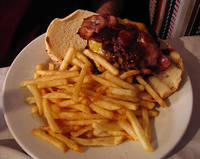
09 Mar Fast Food Servings Have Gotten Bigger and Saltier
MedicalResearch.com Interview with:

Dr. McCrory
Megan A McCrory, PhD, FTOS
Research Associate Professor
Dept of Health Sciences
Sargent College of Health and Rehabilitation Sciences
Boston University 02215
MedicalResearch.com: What is the background for this study?
Response: The prevalence of overweight and obesity has increased in the US, along with documented increases in portion size in the food supply. Fast food is popular, making up about 11% of adult daily calorie intake in the US, and over 1/3 of U.S. adults eat at fast food establishments on any given day. We therefore sought to examine changes in portion size, calories, and selected nutrients in fast-food entree, side, and dessert menu items across the years 1986, 1991, and 2016.
MedicalResearch.com: What are the main findings?
Response: Our main findings were that over the 30 year period, entrees, sides, and desserts increased significantly in calories and sodium, while entrees and desserts also increased significantly in portion size.
The largest increases were seen in desserts for calories and portion size (186 calories, 72 grams) followed by entrees (90 calories, 39 grams). The largest increase in sodium was seen in entrees (13.8 % daily value).
MedicalResearch.com: What should readers take away from your report?
Response: Readers should take away that the changes in fast-food menu offerings have been broadly detrimental.
MedicalResearch.com: What recommendations do you have for future research as a result of this work?
Response: Research is needed to find effective ways to help consumers reduce their consumption of fast food as part of multiple dietary-related ways to improve the health of Americans as a whole.
MedicalResearch.com: Is there anything else you would like to add? Any disclosures?
Response: Consumers of fast food who want to eat better while dining at fast food restaurants can take steps to reduce their intake of calories and sodium in a number of ways. Some possibilities include ordering single instead of double burgers, small size of desserts instead of large, and sharing a single order of French fries with a friend. In this way, consumers will be consuming fewer calories and sodium from their fast food meals but will still enjoy the taste of their favorite fast foods. As always, they can also make substitutions for “healthier” fast foods such as having a salad instead of a burger; but this is a large change and may not be to some consumers’ liking.
No disclosures
Citations:
McCrory, Megan A. et al.
Journal of the Academy of Nutrition and Dietetics , Volume 0 , Issue 0 ,
MedicalResearch.com is not a forum for the exchange of personal medical information, advice or the promotion of self-destructive behavior (e.g., eating disorders, suicide). While you may freely discuss your troubles, you should not look to the Website for information or advice on such topics. Instead, we recommend that you talk in person with a trusted medical professional.
The information on MedicalResearch.com is provided for educational purposes only, and is in no way intended to diagnose, cure, or treat any medical or other condition. Always seek the advice of your physician or other qualified health and ask your doctor any questions you may have regarding a medical condition. In addition to all other limitations and disclaimers in this agreement, service provider and its third party providers disclaim any liability or loss in connection with the content provided on this website.
Last Updated on March 9, 2019 by Marie Benz MD FAAD
